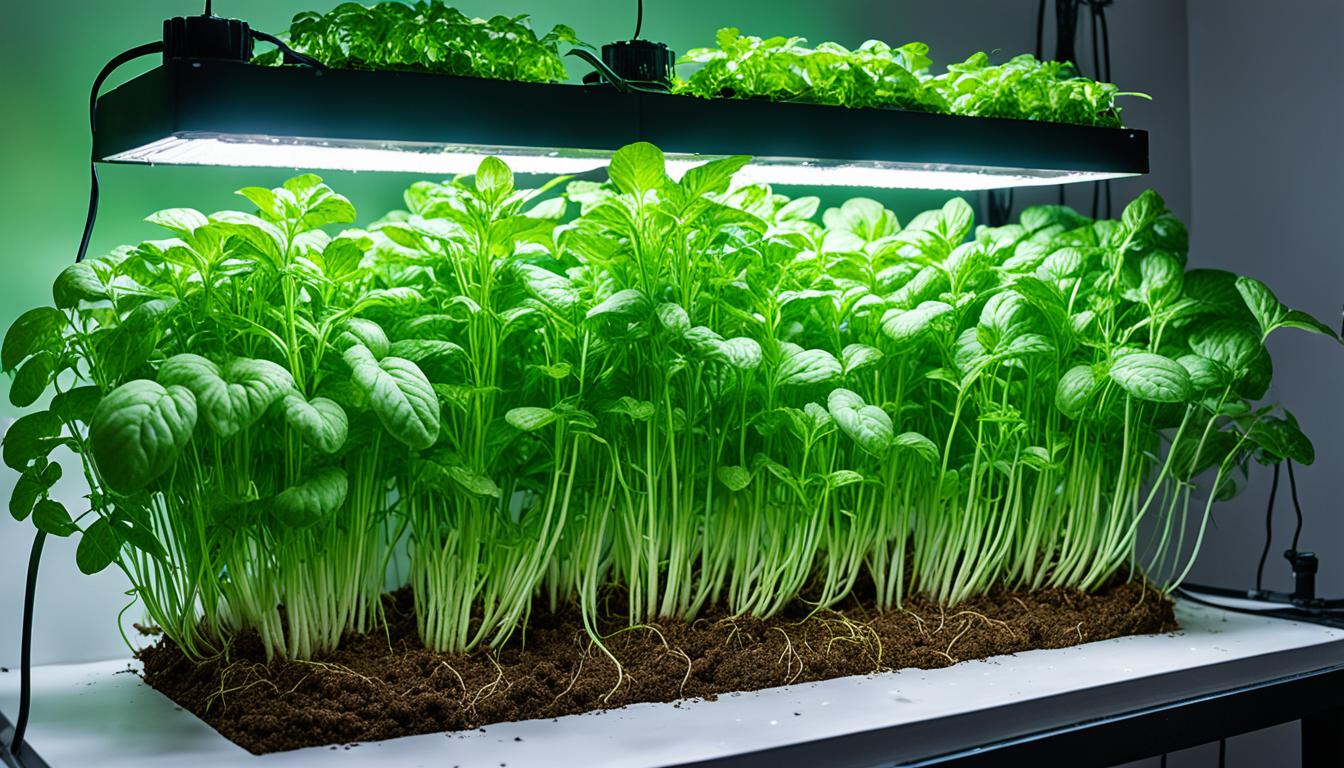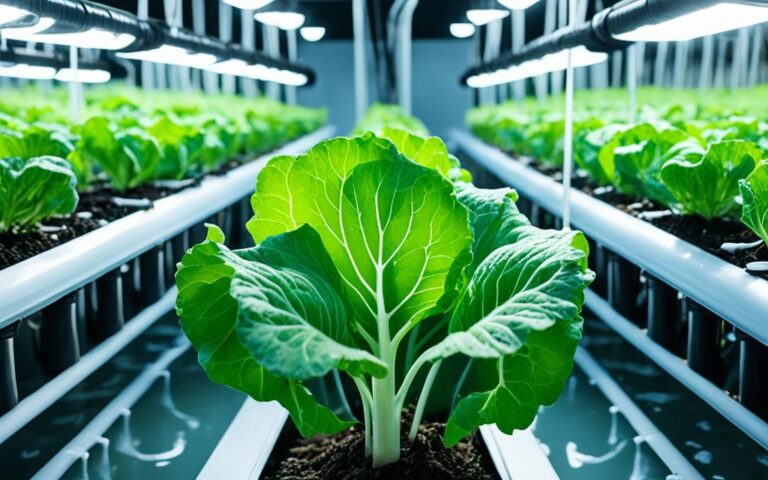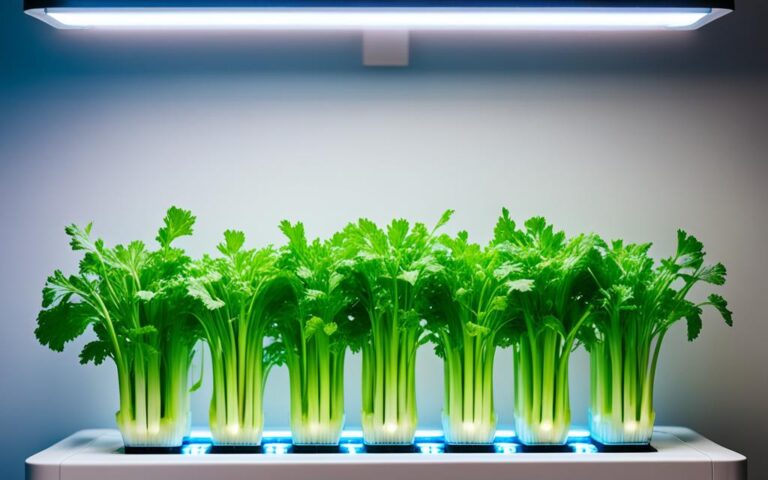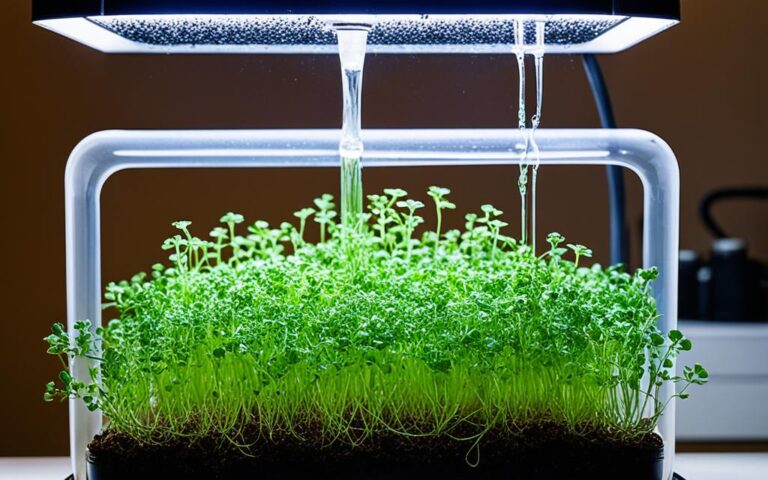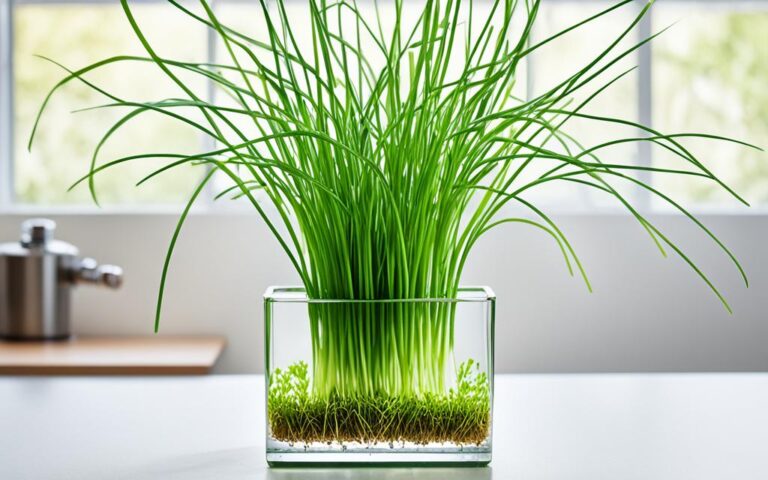Growing Hydroponic Potatoes: A Soilless Solution
The world’s population is growing fast, expected to hit 9.7 billion by 2050. This means we need more food, but we don’t have much land left. Finding new ways to farm is key to keeping everyone fed. Potatoes are a vital crop, helping us meet these challenges.
Hydroponic potato farming is a new way to grow potatoes without soil. It can help us produce more food with less land. By using nutrient-rich solutions, hydroponics can make farming more efficient and sustainable. This method also helps reduce the harm farming can do to the environment.
Key Takeaways
- Hydroponic potato cultivation can yield higher production compared to traditional field-grown methods.
- Soilless farming systems offer a sustainable solution to address land and water constraints for food production.
- Hydroponic systems allow for precise control over nutrient delivery, pH, and environmental conditions for optimal potato growth.
- Hydroponic potatoes can maintain tuber dry matter content and nutritional value superior to field-grown counterparts.
- Specialized hydroponic techniques, such as the Nutrient Film Technique (NFT) and aeroponics, have demonstrated promising results for potato minituber production.
Table of Contents
Introduction to Hydroponic Potato Cultivation
Hydroponic potato cultivation is a new way to grow potatoes without soil. It offers many benefits that help solve problems in traditional farming. This method uses soilless farming to improve potato production.
Benefits of Soilless Farming
Hydroponic systems have many advantages over traditional farming. They can increase potato production by 300% compared to old methods [1]. Also, using precise nutrient delivery can boost yields by 30% more than older methods [2].
Overcoming Land and Water Constraints
Hydroponic potato farming helps with land and water issues. It doesn’t need soil, so it works well in areas with little land. This makes it great for improving food security in places with land and water problems. Plus, it uses less water and nutrients, making it more sustainable.
Using hydroponic potato farming can greatly improve farming. It increases yields and quality and solves soil-based farming problems. This method is a key part of the future of sustainable food production.
| Discount | Order Value |
|---|---|
| 5% off | $0+ |
| 10% off | $150+ |
| 20% off | $500+ |
| 25% off | $1,995+ |
“Hydroponic potato cultivation is a revolutionary approach to growing this versatile crop without the constraints of traditional soil-based farming.”
Selecting the Right Hydroponic System
When growing potatoes hydroponically, two systems stand out: Deep Water Culture (DWC) and Nutrient Film Technique (NFT). Each has its own benefits and things to consider. It’s key for growers to pick the best one for their needs and setup.
Deep Water Culture (DWC) Systems
DWC systems are simple yet effective. They keep the potato plants’ roots in a nutrient-rich solution. This setup is great for potatoes, needing little upkeep. Studies show hydroponics can save up to 90% more water than traditional farming, making DWC a smart choice for water conservation.
Nutrient Film Technique (NFT) Systems
NFT systems use a flowing nutrient solution for the plants. This method is popular for quick-growing crops like lettuce and spinach. While not typical for potatoes, NFT can work by adjusting the nutrients and pH levels.
The choice between DWC and NFT depends on the grower’s scale, space, and experience. Both systems can grow hydroponic potatoes well, if the grower knows the specific needs and adjustments for best growth.
| Hydroponic System | Key Features | Ideal Crops | Maintenance Needs |
|---|---|---|---|
| Deep Water Culture (DWC) | Roots submerged in nutrient-rich solution Constant water and nutrient supply Simple and effective setup |
|
|
| Nutrient Film Technique (NFT) |
|
|
|
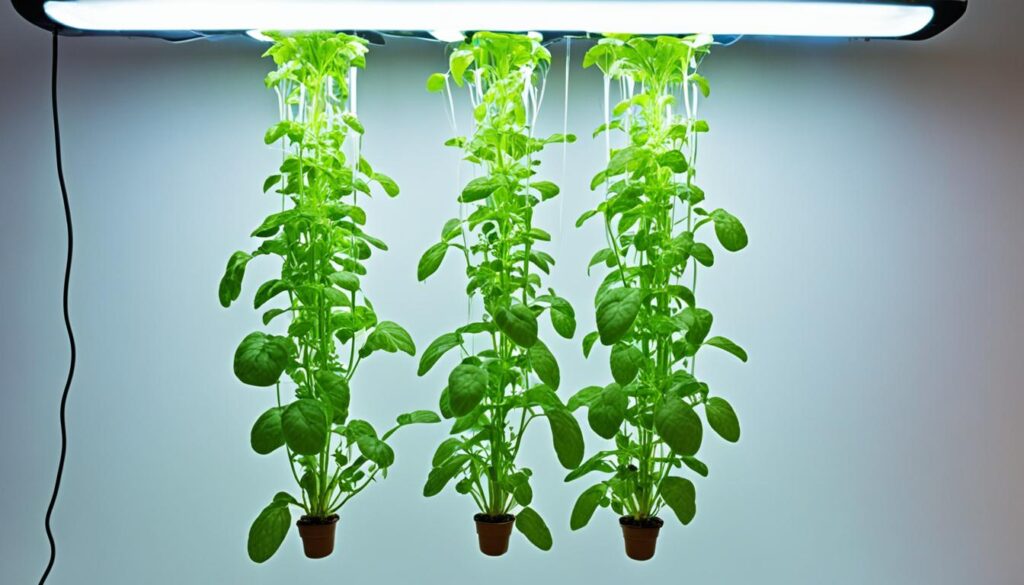
Setting Up Your Hydroponic Potato System
Switching to hydroponic potato farming is both exciting and rewarding. You can pick a Deep Water Culture (DWC) system or go for the Nutrient Film Technique (NFT). Each method has key steps to make sure your hydroponic potato setup succeeds. Let’s look at what you need to do to set up your hydroponic potato system.
Selecting the Right Container and Growing Medium
First, choose the right container or grow channels for your hydroponic potatoes. They should be big enough for the plant’s roots and tubers. You can use plastic containers, old PVC pipes, or even a repurposed wooden baby’s crib to save money and be eco-friendly.
Next, pick a good growing medium. Go for something like coconut coir, perlite, or expanded clay balls. These materials support the roots, provide air, and help the potatoes get nutrients and water well.
Preparing the Nutrient Solution
The nutrient solution is crucial for your hydroponic potatoes. Mix the right amounts of nitrogen, phosphorus, and potassium for a balanced diet for your plants. Keep the pH and electrical conductivity (EC) levels right for best nutrient uptake and plant health.
Hydroponics uses much less water than soil farming, leading to bigger yields because nutrients are always available. The system is also energy-efficient, using a small pump that only needs 18 watts to work. This is less power than a CFL bulb or about a third of an Aerogarden’s power.
Assembling the Hydroponic System
With your container, medium, and nutrient solution ready, it’s time to put the system together. For an NFT setup, lay out the PVC pipes or channels for the nutrient solution to flow through. Make sure everything is level and the water flows smoothly to help the roots grow well.
The setup we’re talking about uses recycled materials like old PVC pipes and a wooden baby’s crib crib to save money and reduce waste. It also suggests using plastic cups for plant support to keep the hydroponic medium in place and help roots grow.
Using a nutrient film technique (NFT) system with PVC pipes keeps water flowing constantly with all the nutrients your plants need. It’s important to have oxygen in the water for the roots. That’s why materials like perlite, vermiculite, and expanded clay balls are used to support the plants.
Choosing the Best Potato Varieties
Choosing the right potato variety is key to success in hydroponics. Some potatoes are better for growing without soil. They have high yield, resist diseases, and fit well in hydroponic systems.
High-Yielding Hydroponic Varieties
Here are some top hydroponic potato varieties:
- Celandine – A high-yielding variety known for its excellent disease resistance and ability to thrive in hydroponic setups.
- Yukon Gold – A popular all-purpose potato that produces a bountiful harvest in hydroponic systems.
- Fingerling – These small, elongated potatoes are well-suited for compact hydroponic growing, often yielding impressive results.
It’s important to research and try different potatoes to see which works best for you. Look for varieties that have high yield, resist diseases, and adapt well to hydroponics.
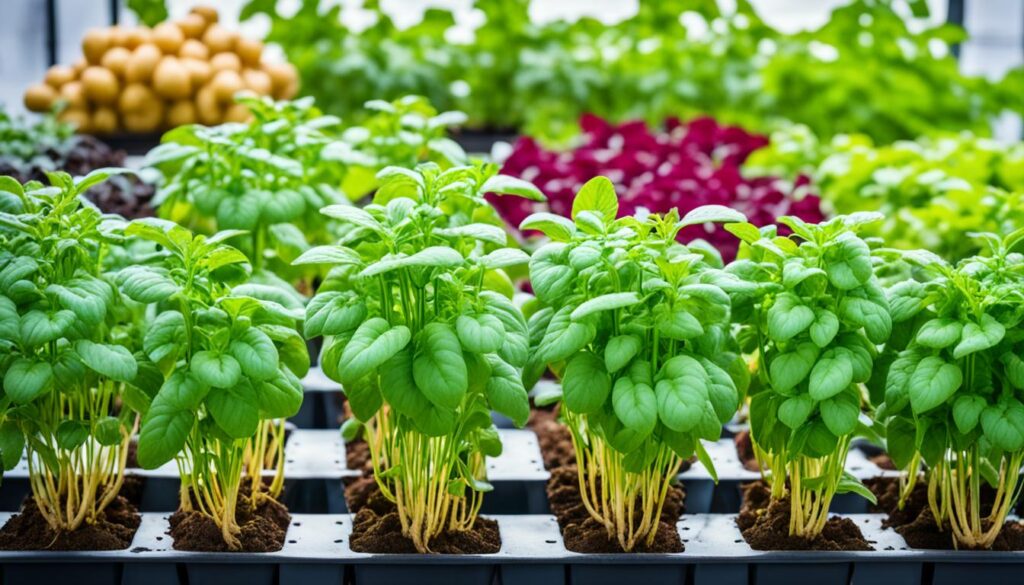
“Potatoes require low maintenance and can be harvested before the end of the spring semester, making them suitable for students such as those at UNC.”
By picking the right potatoes, hydroponic growers can get great yields and a successful harvest without traditional soil.
Nutrient Management for Hydroponic Potatoes
Getting the nutrients right is key to growing hydroponic potatoes well. Potatoes need a mix of nitrogen, phosphorus, and potassium to grow and produce tubers. It’s important to keep an eye on the pH and EC levels of the nutrient solution. This helps the plants absorb the nutrients they need.
Essential Nutrients and Fertilizers
Potatoes in hydroponics need 17 essential nutrients to do well. These include macronutrients like carbon, hydrogen, oxygen, and nitrogen. They also need micronutrients like iron and zinc for good health.
It’s important to balance these nutrients in the solution. This ensures the potatoes grow well and produce lots of tubers.
Monitoring and Adjusting pH and EC
Keeping the pH and electrical conductivity (EC) right is key for nutrient uptake and plant health. The ideal pH for hydroponic potatoes is 5.5 to 6.5. The EC should be between 1400 and 1700 ppm.
Checking and adjusting these levels often is crucial. It helps avoid nutrient problems that can slow down plant growth.
| Nutrient | Deficiency Symptoms | Causes |
|---|---|---|
| Nitrogen (N) | Light green foliage, overall stunting, wilting, dead/yellow leaf margins | Under-fertilization, nutrient imbalance, low pH |
| Calcium (Ca) | Brown leaf margins, tipburn, blossom end rot | Under-fertilization, nutrient imbalance, low pH, moisture, temperature, airflow |
| Soluble Salts | Wilting despite adequate irrigation, dark green foliage, dead/burned leaf margins, root death | Over-fertilization, poor water quality |
By keeping an eye on the pH and EC, growers can make sure their potatoes get the nutrients they need. This leads to better growth and more tubers.
Environmental Control for Optimal Growth
For hydroponic potatoes to grow well, the environment must be just right. This means keeping an eye on temperature and light is key.
Temperature and Light Requirements
Potatoes do best in temperatures between 65°F and 75°F. Growers might use heaters or coolers to keep it perfect, based on where they are. They also need at least 6 hours of sunlight a day to grow strong.
If there’s not enough sunlight, growers can use extra lights for 10-12 hours a day. This makes sure the plants get enough light.
Keeping the environment right is vital for strong plants and big, quality tubers. By controlling temperature and light, growers can make sure their potatoes grow well and produce a lot.

“By the year 2050, Earth will have to feed an additional 2.3 billion people. Conventional farming practices could deplete soil nutrients and contaminate freshwater supplies with pesticides and herbicides. Hydroponic farming, with its precise control over the growing environment, offers a sustainable solution to address these challenges.”
For hydroponic potatoes, it’s important to control the environment well. Following the right temperature and light rules is key for great growth and lots of potatoes.
hydroponic Potatoes: Planting and Caring
Growing potatoes in a hydroponic system offers two options: seed tubers or transplants. Seed tubers can be cut into pieces with at least one eye each. Then, they can be planted directly into the growing medium. Or, you can start with transplants, growing the plants in a nursery before moving them to the hydroponic setup.
From Seed Tubers to Transplants
Choosing the right method is crucial for the success of potato plants in hydroponics. Red or yellow-skinned potatoes like Yukon Gold, Red Pontiac, and Yellow Finnish work well in hydroponics. Fingerling potatoes, such as Russian Banana, Ozette, or Ruby Crescent, are also great because of their shape. Extra-early potatoes can grow into full-size tubers in just 2-3 months indoors.
For a bountiful harvest, consistency and care are essential. Hydroponic potatoes can mature up to a month faster than those grown in soil. A hydroponic setup includes a container filled with perlite, placed in a sunny spot for at least six hours a day. Plant seed potatoes or pieces about 4 to 6 inches apart, with the cut side down, and cover with 1 inch of perlite. Water them every three to five days with tap water to keep the perlite moist.
Harvest mature tubers three weeks after the vines die, or pick smaller ones at 70 days. This quick growth and early harvest are big pluses of hydroponic potatoes.
“Consistency and care are key to maximizing harvest in hydroponic potato cultivation.”
Integrated Pest and Disease Management
Hydroponic systems can lessen the risk of pests and diseases compared to soil farming. Yet, growers must watch closely for any issues. Using a mix of cultural, biological, and chemical controls is key to keeping hydroponic potatoes healthy and productive.
Common Pests and Diseases in Hydroponics
Aphids, spider mites, and whiteflies are common pests in hydroponic potatoes. They can harm the plants and cut yields. Diseases like late blight, early blight, and soft rot are also issues for growers.
Growers can fight these problems with various methods:
- Regular monitoring and scouting to catch issues early
- Beneficial insects and biological controls to manage pests
- Proper sanitation, like removing infected plants and cleaning tools
- Rotating crops and using resistant varieties to stop diseases from spreading
- Using low-toxicity, organic pesticides only when needed
These strategies help hydroponic potato growers manage pests and diseases well. They also protect the environment and human health.
“Greenhouse Integrated Pest Management (IPM) incorporates strategies to prevent pest damage with minimal adverse effects on human health and the environment.”
Good IPM programs include steps like prevention, monitoring, and accurate diagnosis. They also involve setting control thresholds and using efficient management methods. Important prevention techniques are advanced crop planning, sanitation, environmental management, and cultural methods.
Maximizing Yield and Quality
Hydroponic potato farming lets growers boost their crop’s yield and quality. By using smart techniques, growers can make the most of their hydroponic potato farming. This leads to bigger, better-quality tubers.
Tips for Bigger and Better Potatoes
To grow bigger and better hydroponic potatoes, follow these steps:
- Keep a balanced nutrient mix: Make sure there’s the right amount of nitrogen, phosphorus, potassium, iron, manganese, and zinc.
- Control the growing space: Adjust temperature, light, and humidity to help potatoes grow and develop well.
- Manage pests and diseases: Watch for pests and diseases, and act fast to stop them from spreading.
- Support the plants: Use stakes or trellises to help the plants grow, making bigger, better tubers.
- Check and tweak the hydroponic setup: Keep an eye on the pH, EC, and nutrient levels to make sure your potatoes grow well.
By following these tips, growers can improve the yield and quality of their hydroponic potatoes. They’ll get a great harvest of bigger and better potatoes.
“Hydroponics is a water-efficient solution, recycling and reusing water, reducing water consumption.”
Harvesting and Storage Techniques
Getting the harvest and storage right is key for keeping hydroponic potatoes fresh for a long time. Growers should wait until the plants start to yellow and die back, usually 90-120 days after planting. This is when the potatoes are ready.
When it’s time to pick, take out the whole plant carefully from the hydroponic setup. This avoids damaging the potatoes. Then, let the tubers cure in a cool, dark spot for 1-2 weeks. This helps any cuts or bruises heal, getting the potatoes ready for storage.
After curing, hydroponic potatoes can stay fresh in a cool, dark place for months. Keeping them in a spot with temperatures between 55 and 65 degrees Fahrenheit and humidity around 85% is important. This keeps the potatoes fresh and stops them from spoiling.
Check on the stored potatoes often and remove any sprouts. This stops them from sprouting too soon and rotting. Also, keep them away from fruits like apples and onions. These can make the potatoes go bad faster.
Learning how to harvest and store hydroponic potatoes well can help growers get the most from their crop. This way, they can offer fresh, tasty potatoes to their customers or enjoy them at home.
Unlocking the Potential of Hydroponic Potatoes
Here are some tips to improve harvesting and storing hydroponic potatoes:
- Harvest potatoes two weeks after the vines flower or when the vines die back for the best tubers.
- Keep the potato vines moist with an inch of water each week to grow well.
- Store potatoes in a cool, dry, dark place to keep them fresh. Aim for temperatures between 55 and 65 degrees Fahrenheit and humidity around 85%.
- Take out any sprouts on stored potatoes often to stop them from sprouting too soon and rotting.
- Don’t store potatoes near apples, fruits, or onions. The gases from these can make the potatoes go bad faster.
| Potato Storage Duration | Optimal Conditions |
|---|---|
| Main crop potatoes | 3 to 6 months or longer if kept in the right conditions |
| First and second early potatoes | 1 to 2 months |
By following these tips for harvesting and storing hydroponic potatoes, growers can keep their crop fresh and quality high. This makes the most of this soilless growing method.
Advantages of Hydroponic Potato Farming
Hydroponic potato farming has big benefits over traditional farming. It doesn’t need much land, making it great for cities and towns. This way, more food can be grown and resources saved.
Resource Efficiency and Sustainability
Hydroponic potato cultivation is very efficient with resources and sustainable. It uses up to 90% less water than traditional farming. This is a big plus in areas where water is scarce or the weather is harsh.
Also, hydroponics lets farmers control exactly what plants get. This means better yields and quality of potatoes. Studies show hydroponic farming can produce 300% more tubers than traditional methods. It also leads to 30% more fresh matter yield with a single drip system.
| Metric | Hydroponic Potato Cultivation | Conventional Potato Farming |
|---|---|---|
| Water Usage | Up to 90% less | Higher water consumption |
| Yield | Up to 300% higher tuber production | Lower yields |
| Nutrient Efficiency | 30% higher fresh matter yield with single-drip method | Potential nutrient loss and imbalance |
Hydroponic potato farming also offers quality benefits. Farmers can grow potatoes that meet specific market needs. For example, some varieties are better suited for the market than others.
In summary, hydroponic potato farming is great for saving resources, being sustainable, and growing high-quality potatoes. These points make it a top choice for modern farming.
Challenges and Considerations
Hydroponic potato farming has many benefits, but it also has challenges. One big challenge is the high cost to set up a hydroponic system. This can be more expensive than farming in soil. Growers need to know a lot about the system to make it work right. If they don’t, they might lose their whole crop.
Pests and diseases can be a big problem in hydroponic potato farming. They can spread faster than in soil farming. Growers must watch closely and take action to keep their crops healthy. Also, hydroponic potatoes might taste or feel different from those grown in soil. This could affect some consumers.
| Challenge | Consideration |
|---|---|
| Higher Initial Setup Cost | Growers must be willing to invest in the necessary equipment and infrastructure for a hydroponic system, which can be more expensive than traditional soil-based farming. |
| Technical Knowledge Required | Successful hydroponic potato farming requires a certain level of expertise in managing the system, monitoring nutrient levels, and troubleshooting any issues that may arise. |
| Potential for Crop Failure | If the hydroponic system fails or pests and diseases are not properly managed, the risk of crop failure is higher compared to soil-based farming. |
| Taste and Texture Differences | Hydroponically grown potatoes may have a slightly different taste and texture compared to those grown in soil, which could be a consideration for some consumers. |
Even with challenges, hydroponic potato farming can be a good choice for growers. They just need to invest in the right resources and learn how to use them. With good planning and care, hydroponic farming can be a great way to grow potatoes without using a lot of land or water.
“Hydroponic potato farming offers a soilless solution to overcome land and water constraints, but growers must be mindful of the initial setup costs and technical requirements to ensure successful crop production.”
Conclusion
Hydroponic potato farming is a great way to meet the world’s growing need for potatoes. It’s especially useful in places with little land and water. This method lets farmers grow more potatoes, control diseases better, and harvest all year round.
Starting hydroponic potato farming can be costly and requires some knowledge. But, the benefits are clear. It helps grow disease-resistant potatoes quickly, manages nutrients precisely, and protects against weather changes. This makes hydroponics a better choice for farming.
As technology and knowledge improve, hydroponic potato farming looks even brighter. It helps farmers meet the demand for potatoes while saving resources and protecting the environment. This article shows how hydroponic farming could be a key solution for agriculture’s big challenges.
